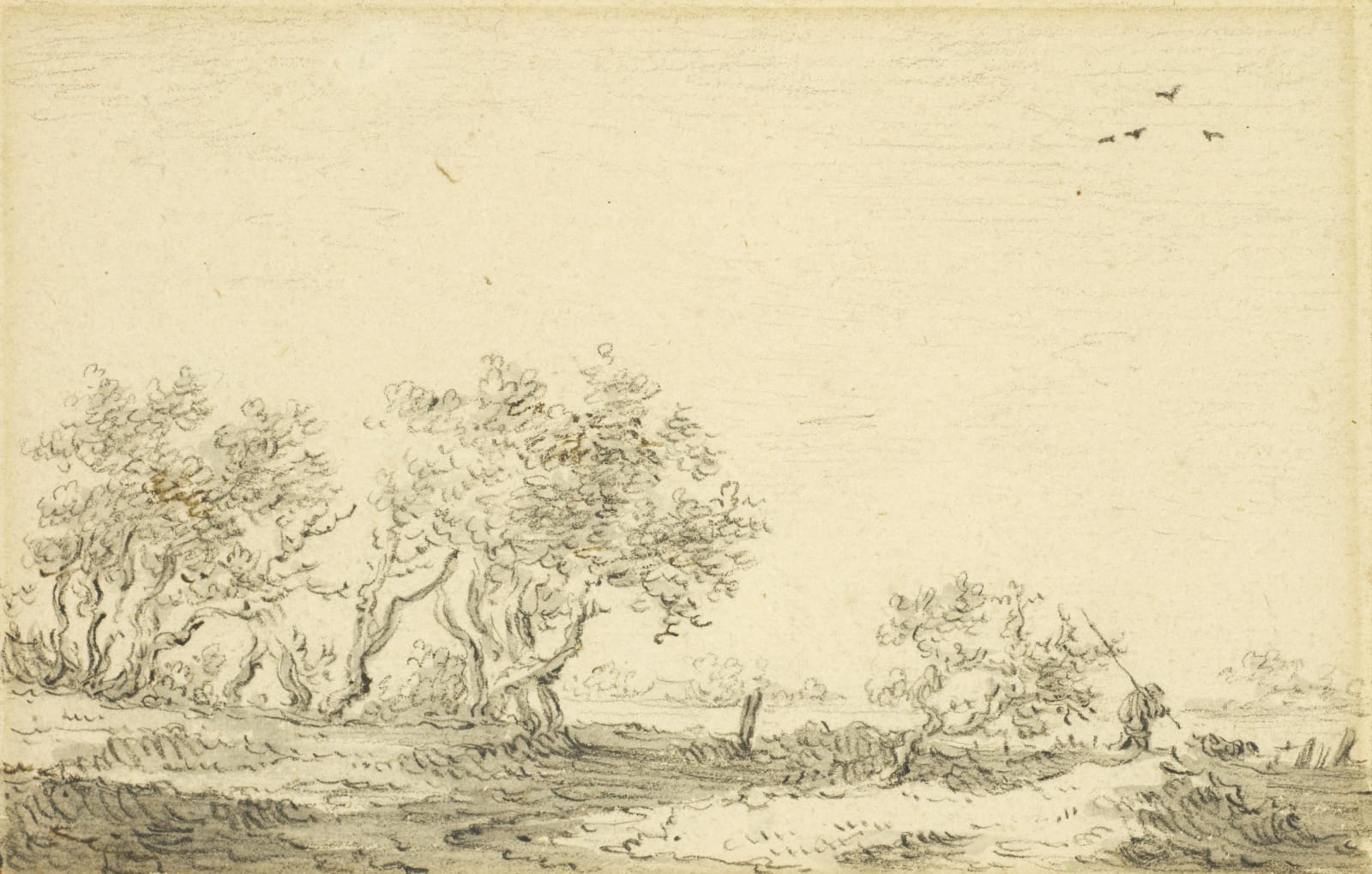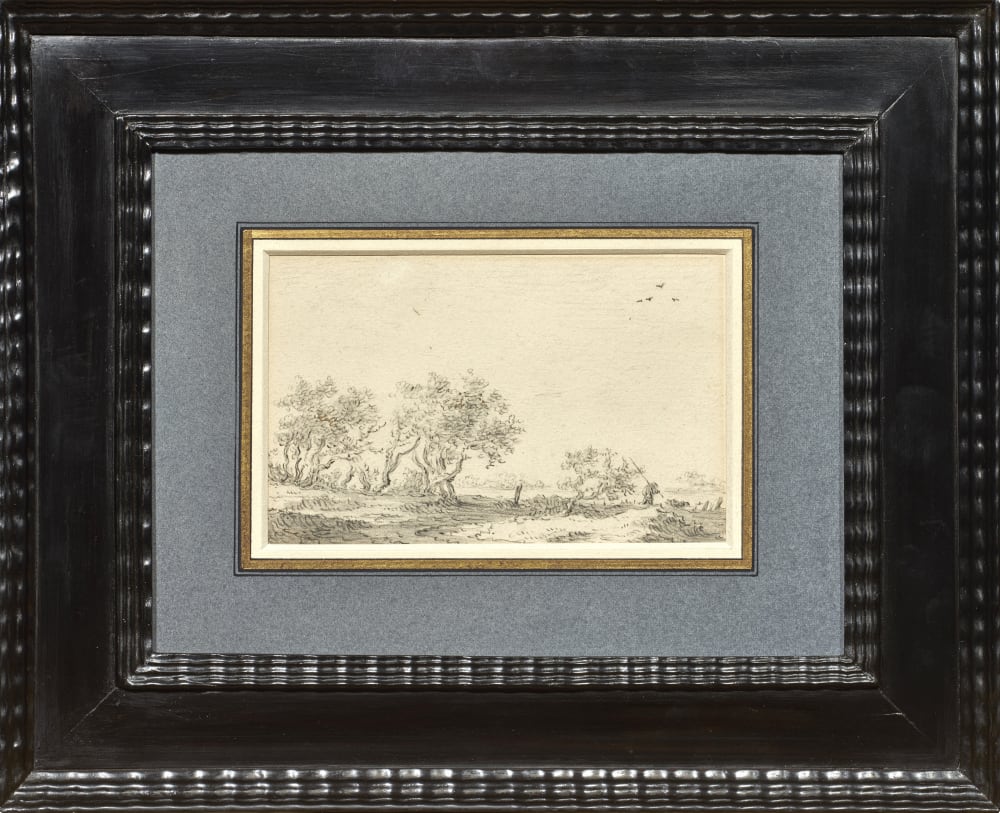 Jan van Goyen - Four figures on a mound - location unknown
Jan van Goyen - Four figures on a mound - location unknown
Jan van Goyen Dutch School, 1596-1656
9.2 x 14.2 cm
Further images
Provenance
Alfred Brod Gallery, London; English private collection since 1965
No Dutch draughtsman ever captured the atmosphere of the rural countryside of Holland with the same atmospheric and engaging simplicity that Van Goyen achieved in drawings such as this. Indeed, his landscapes were seminal in the development of the genre. The present sketch conveys a striking sense of movement within the natural landscape, conveyed by the deftly applied strokes of chalk, from which the artist’s hand can be sensed. The composition is characteristic of his work, with the low horizon affording significance to the broad sky and the soaring birds within. This feeling of windswept motion powerfully evokes the expansive Dutch farmland with which he was evidently preoccupied.
1. Jan van Goyen, a pioneer in Dutch landscape painting
Jan van Goyen was ambitious in his yearning for prosperity and recognition. Son of a cobbler in Leiden, he was apprenticed at the young age of ten to local painters. After a year of travelling through France, Van Goyen's received his formative training from the landscapist Esaias van de Velde in Haarlem in 1617. Haarlem, centre of monochrome still lifes, put Jan van Goyen forward as the first and leading painter of Dutch tonal landscapes.
Eventually, Van Goyen moved to the court city, The Hague, where he became head of the Guild of Saint Luke. Regardless his substantial artistic output, Van Goyen was also active (although not very successful) as an art collector, dealer, auctioneer, appraiser, tulip and real estate investor. Surrounded by artists, he let the adjoining house to acclaimed fellow landscapist Paulus Potter. Two of Van Goyen's daughters married respectively his student, the genre painter Jan Steen and still life painter Jacques de Claeuw. Van Goyen's portrait by acclaimed colleague Gerard ter Borch confirms his prominent position among the Dutch artworld elite.
Van Goyen travelled the length and breadth of the Netherlands recording details of landscape and topography in black chalk. A small sketchbook tucked into his pocket, the draughtsman in search of inspiration could quickly delineate sand dunes and architectural structures in the vicinity of his hometown or accompany him on extended journeys. Back in his studio, the sketches would provide endless inspiration, combining different motifs into imaginary landscape compositions. These drawings not only functioned as preliminary studies for motifs in paintings, Van Goyen at times also reworked them into larger, more finished drawings, typically monogrammed and dated, and intended for sale. Never attempting to depict accurate views, Van Goyen's preliminary studies unfold as topographical elements in his composite landscapes.
His graphic work was inventoried by Beck in 1972 and included several hundred drawings; more than a thousand have been recorded today. Almost exclusively executed in black chalk at the beginning, these drawings were enriched from the end of the 1640s onwards with a light wash of grey or brown ink, like the one presented here.
2. Description of the artwork
A group of trees along a river, a fisherman walking with his dog, a fishing rod on his shoulder, the description of this landscape seems banal. But the atmospheric rendering is the real subject here: the immense sky shaded by discreet lines of black chalk in which a few birds fly, the dunes where the play of light and wind creates deep contrasts between areas of shadow and full clarity (rendered by a masterful use of reserves).
Despite its small size and the fact that it was taken from life, the extreme composition of our drawing must be emphasised. Our landscape is organised around a diagonal running from the lower left to the upper right, following the edge of the mound at the bottom left and the tree tops in the middle of the composition. There is a strong contrast between the movement of the trees and the direction taken by the fisherman and its dog, and the flight of birds in the sky in the opposite direction.
Van Goyen's technique is remarkable for its skill and precision: with a comma or a loop he brings a character to life, and a touch of wash is enough to convey the atmosphere. Our drawing has not been listed by Beck, but in the supplement to the catalogue raisonné published in 1987 (under number 409) there is a composition with broad similarities.
3. Framing
We have chosen to frame this drawing in a Dutch ebony veneer frame which brings out the grey range in which our landscape develops (with some imperceptible touches of brown in the foliage of the trees).
Main bibliographic sources :
Hans-Ulrich Beck - Jan van Goyen 1596 - 1656. Ein Oeuvreverzeichnis - Van Gendt & Co. Amsterdam 1972 - Ergänzungen zum Katalog - Davaco 1987
(collective) - Regards sur l'art hollandais du XVIIème siècle - Fondation Custodia 2004





